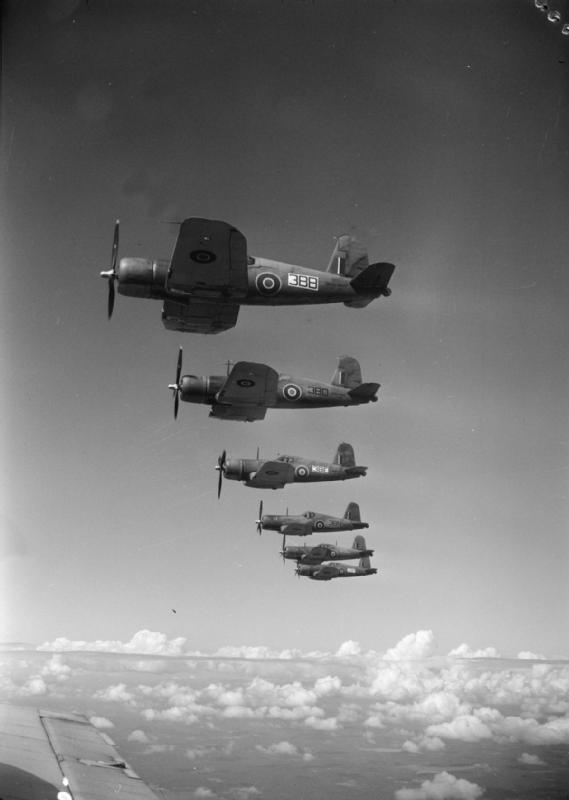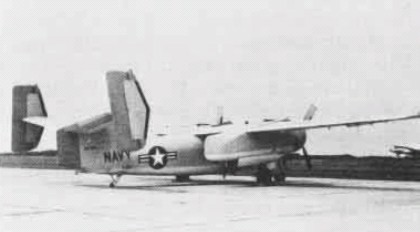|
Vought XS2U
The Vought XS2U was a design for an all-weather, carrier-based anti-submarine warfare (ASW) aircraft. A twin-engine, twin-tailed, mid-wing, propeller-driven design with tricycle landing gear, it lost to the Grumman S2F Tracker in the United States Navy competition, and the two prototypes were not completed. Design and development Vought, Chance Vought Aircraft began work on 25 January 1950 on a U.S. Navy proposal for an all-weather anti-submarine warfare design. The company constructed a full-scale mock-up of the XS2U-1 and received a contract-of-intent for two XS2U-1 prototypes, BuNos ''133780'' and ''133781'', which were not completed before development was abandoned. Three-blade propellers similar to those used on the S2F were installed on the mock-up, which had a two-wheel nosegear, and single-tire main gear that would retract into the engine nacelles. The twin-tail fins were canted inward, 90 degrees from the tailplane dihedral. Construction was begun on the fuselages and w ... [...More Info...] [...Related Items...] OR: [Wikipedia] [Google] [Baidu] |
Anti-submarine Warfare
Anti-submarine warfare (ASW, or in older form A/S) is a branch of underwater warfare that uses surface warships, aircraft, submarines, or other platforms, to find, track, and deter, damage, or destroy enemy submarines. Such operations are typically carried out to protect friendly shipping and coastal facilities from submarine attacks and to overcome blockades. Successful ASW operations typically involved a combination of sensor and weapon technologies, along with effective deployment strategies and sufficiently trained personnel. Typically, sophisticated sonar equipment is used for first detecting, then classifying, locating, and tracking a target submarine. Sensors are therefore a key element of ASW. Common weapons for attacking submarines include torpedoes and naval mines, which can both be launched from an array of air, surface, and underwater platforms. ASW capabilities are often considered of significant strategic importance, particularly following provocative instances ... [...More Info...] [...Related Items...] OR: [Wikipedia] [Google] [Baidu] |
Vought
Vought was the name of several related American aerospace firms. These have included, in the past, Lewis and Vought Corporation, Chance Vought, Vought-Sikorsky, LTV Aerospace (part of Ling-Temco-Vought), Vought Aircraft Companies, and Vought Aircraft Industries. The first incarnation of Vought was established by Chance M. Vought and Birdseye Lewis in 1917. In 1928, it was acquired by United Aircraft and Transport Corporation, which a few years later became United Aircraft Corporation; this was the first of many reorganizations and buyouts. During the 1920s and 1930s, Vought Aircraft and Chance Vought specialized in carrier-based aircraft for the United States Navy, by far its biggest customer. Chance Vought produced thousands of planes during World War II, including the F4U Corsair. Vought became independent again in 1954, and was purchased by Ling-Temco-Vought (LTV) in 1961. The company designed and produced a variety of planes and missiles throughout the Cold War. Vought ... [...More Info...] [...Related Items...] OR: [Wikipedia] [Google] [Baidu] |
Carrier-based
Carrier-based aircraft, sometimes known as carrier-capable aircraft or carrier-borne aircraft, are naval aircraft designed for operations from aircraft carriers. They must be able to launch in a short distance and be sturdy enough to withstand the abrupt forces of launching from and recovering on a pitching deck. In addition, their wings are generally able to fold up, easing operations in tight quarters. Such aircraft are designed for many purposes including air-to-air combat, surface attack, anti-submarine warfare (ASW), search and rescue (SAR), transport (COD), weather observation, reconnaissance and airborne early warning and control (AEW&C) duties.Fred T Jane (2005). ''Jane's All the World's Aircraft''. Jane's Information Group. The term is generally applied only to fixed-wing aircraft, as naval helicopters are able to operate from a wider variety of ships, including helicopter carriers, destroyers, frigates and container ships. History The 1903 advent of fix ... [...More Info...] [...Related Items...] OR: [Wikipedia] [Google] [Baidu] |
Anti-submarine Warfare
Anti-submarine warfare (ASW, or in older form A/S) is a branch of underwater warfare that uses surface warships, aircraft, submarines, or other platforms, to find, track, and deter, damage, or destroy enemy submarines. Such operations are typically carried out to protect friendly shipping and coastal facilities from submarine attacks and to overcome blockades. Successful ASW operations typically involved a combination of sensor and weapon technologies, along with effective deployment strategies and sufficiently trained personnel. Typically, sophisticated sonar equipment is used for first detecting, then classifying, locating, and tracking a target submarine. Sensors are therefore a key element of ASW. Common weapons for attacking submarines include torpedoes and naval mines, which can both be launched from an array of air, surface, and underwater platforms. ASW capabilities are often considered of significant strategic importance, particularly following provocative instances ... [...More Info...] [...Related Items...] OR: [Wikipedia] [Google] [Baidu] |
Grumman S2F Tracker
The Grumman S-2 Tracker (S2F prior to 1962) was the first purpose-built, single airframe anti-submarine warfare (ASW) aircraft to enter service with the United States Navy. Designed and initially built by Grumman, the Tracker was of conventional design — propeller-driven with twin radial engines, a high wing that could be folded for storage on aircraft carriers, and tricycle undercarriage. The type was exported to a number of navies around the world. Introduced in 1952, the Tracker and its E-1 Tracer derivative saw service in the U.S. Navy until the mid-1970s, and its C-1 Trader derivative until the mid-1980s, with a few aircraft remaining in service with other air arms into the 21st century. Argentina and Brazil are the last countries to still use the Tracker. Design and development The Tracker was intended as a replacement for the Grumman AF Guardian, which was the first purpose-built aircraft system for ASW, using two airframes for two versions, one with the detecti ... [...More Info...] [...Related Items...] OR: [Wikipedia] [Google] [Baidu] |
United States Navy
The United States Navy (USN) is the maritime service branch of the United States Armed Forces and one of the eight uniformed services of the United States. It is the largest and most powerful navy in the world, with the estimated tonnage of its active battle fleet alone exceeding the next 13 navies combined, including 11 allies or partner nations of the United States as of 2015. It has the highest combined battle fleet tonnage (4,635,628 tonnes as of 2019) and the world's largest aircraft carrier fleet, with eleven in service, two new carriers under construction, and five other carriers planned. With 336,978 personnel on active duty and 101,583 in the Ready Reserve, the United States Navy is the third largest of the United States military service branches in terms of personnel. It has 290 deployable combat vessels and more than 2,623 operational aircraft . The United States Navy traces its origins to the Continental Navy, which was established during the American Re ... [...More Info...] [...Related Items...] OR: [Wikipedia] [Google] [Baidu] |
Grumman OV-1 Mohawk
The Grumman OV-1 Mohawk is an armed military observation and attack aircraft that was designed for battlefield surveillance and light strike capabilities. It has a twin turboprop configuration, and carries two crew members in side-by-side seating. The Mohawk was intended to operate from short, unimproved runways in support of United States Army maneuver forces. Development The Mohawk began as a joint Army-Marine program through the then-Navy Bureau of Aeronautics (BuAer), for an observation/attack plane that would outperform the Cessna O-1 Bird Dog, Cessna L-19 Bird Dog. In June 1956, the Army issued Type Specification TS145, which called for the development and procurement of a two-seat, twin turboprop aircraft designed to operate from small, unimproved fields under all weather conditions. It would be faster, with greater firepower, and heavier armour than the Bird Dog, which had proved vulnerable during the Korean War. The Mohawk's mission would include observation, Artillery ... [...More Info...] [...Related Items...] OR: [Wikipedia] [Google] [Baidu] |
Grumman WF
The Grumman E-1 Tracer was the first purpose-built airborne early warning aircraft used by the United States Navy. It was a derivative of the Grumman C-1 Trader and entered service in 1958. It was replaced by the more modern Grumman E-2 Hawkeye by the 1970s. Design and development The E-1 was designated WF under the 1922 United States Navy aircraft designation system; the designation earned it the nickname "Willy Fudd". The Tracer was derived from the C-1 Trader, itself a derivative of the S-2 Tracker carrier-based antisubmarine aircraft, known as S2F under the old system, nicknamed "Stoof", leading to the WF/E-1, with its distinctive radome, being known as "Stoof with a Roof."O'Rourke, G.G., CAPT USN. "Of Hosenoses, Stoofs, and Lefthanded Spads". ''United States Naval Institute Proceedings'', July 1968. The E-1 featured folding wings of a very particular design for compact storage aboard aircraft carriers; unlike the S-2 and C-1 in which the wings folded upwards, the rad ... [...More Info...] [...Related Items...] OR: [Wikipedia] [Google] [Baidu] |
Grumman WF Tracer
The Grumman E-1 Tracer was the first purpose-built airborne early warning aircraft used by the United States Navy. It was a derivative of the Grumman C-1 Trader and entered service in 1958. It was replaced by the more modern Grumman E-2 Hawkeye by the 1970s. Design and development The E-1 was designated WF under the 1922 United States Navy aircraft designation system; the designation earned it the nickname "Willy Fudd". The Tracer was derived from the C-1 Trader, itself a derivative of the S-2 Tracker carrier-based antisubmarine aircraft, known as S2F under the old system, nicknamed "Stoof", leading to the WF/E-1, with its distinctive radome, being known as "Stoof with a Roof."O'Rourke, G.G., CAPT USN. "Of Hosenoses, Stoofs, and Lefthanded Spads". ''United States Naval Institute Proceedings'', July 1968. The E-1 featured folding wings of a very particular design for compact storage aboard aircraft carriers; unlike the S-2 and C-1 in which the wings folded upwards, the radome at ... [...More Info...] [...Related Items...] OR: [Wikipedia] [Google] [Baidu] |
Vought Aircraft
Vought was the name of several related American aerospace firms. These have included, in the past, Lewis and Vought Corporation, Chance Vought, Vought-Sikorsky, LTV Aerospace (part of Ling-Temco-Vought), Vought Aircraft Companies, and Vought Aircraft Industries. The first incarnation of Vought was established by Chance M. Vought and Birdseye Lewis in 1917. In 1928, it was acquired by United Aircraft and Transport Corporation, which a few years later became United Aircraft Corporation; this was the first of many reorganizations and buyouts. During the 1920s and 1930s, Vought Aircraft and Chance Vought specialized in carrier-based aircraft for the United States Navy, by far its biggest customer. Chance Vought produced thousands of planes during World War II, including the F4U Corsair. Vought became independent again in 1954, and was purchased by Ling-Temco-Vought (LTV) in 1961. The company designed and produced a variety of planes and missiles throughout the Cold War. Vought was ... [...More Info...] [...Related Items...] OR: [Wikipedia] [Google] [Baidu] |
Cancelled Military Aircraft Projects Of The United States
Cancel or cancellation may refer to: * Flight cancellation and delay, not operating a scheduled flight Sociology * Cancel culture, boycott and ostracism calling out offensive behavior on social media or in real life Technology and science * Cancel leaf, a bibliographic term for replaced leaves in printed books * Cancellation property, the mathematical property if ''a''×''b'' = ''a''×''c'' then ''b'' = ''c'' ** Cancelling out, a technique for simplifying mathematical expressions * Catastrophic cancellation, numerical error arising from subtracting approximations to nearby numbers * Noise cancellation, a method for reducing unwanted sound * Phase cancellation, the effect of two waves that are out of phase with each other being summed * Cancel message, a special message used to remove Usenet articles posted to news servers * Cancel character, an indication that transmitted data are in error or are to be disregarded * Resolution rule, in propositional logic a valid inferen ... [...More Info...] [...Related Items...] OR: [Wikipedia] [Google] [Baidu] |
Twin Piston-engined Tractor Aircraft
Twins are two offspring produced by the same pregnancy.MedicineNet > Definition of TwinLast Editorial Review: 19 June 2000 Twins can be either ''monozygotic'' ('identical'), meaning that they develop from one zygote, which splits and forms two embryos, or ''dizygotic'' ('non-identical' or 'fraternal'), meaning that each twin develops from a separate egg and each egg is fertilized by its own sperm cell. Since identical twins develop from one zygote, they will share the same sex, while fraternal twins may or may not. In rare cases twins can have the same mother and different fathers (heteropaternal superfecundation). In contrast, a fetus that develops alone in the womb (the much more common case, in humans) is called a ''singleton'', and the general term for one offspring of a multiple birth is a ''multiple''. Unrelated look-alikes whose resemblance parallels that of twins are referred to as doppelgängers. Statistics The human twin birth rate in the United States rose 76% from ... [...More Info...] [...Related Items...] OR: [Wikipedia] [Google] [Baidu] |









